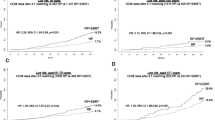Abstract
Aim
To compare cancer-specific mortality (CSM) rates between radical prostatectomy (RP) vs. external beam radiotherapy (RT) in patients with ductal carcinoma (DC) of the prostate.
Materials and methods
Within the Surveillance, Epidemiology, and End Results (SEER) database (2004–2016), we identified 369 DC patients, of whom 303 (82%) vs. 66 (18%) were treated with RP vs. RT, respectively. Kaplan–Meier plots and uni- and stepwise multivariate Cox regression models addressed CSM in the unmatched population. After propensity score matching (PSM) and inverse probability of treatment weighting (IPTW), Kaplan–Meier curve and Cox regression models tested the effect of RP vs RT on CSM.
Results
Overall, RT patients were older, harbored higher PSA values, higher clinical T and higher Gleason grade groups. 5-year CSM rates were respectively 4.2 vs. 10% for RP vs. RT (HR 0.40, 95% CI 0.16–0.99, p = 0.048, favoring RP). At step-by-step multivariate Cox regression, after adding possible confounders, the central tendency of the HR for RP vs. RT approached 1. PSM resulted into 124 vs. 53 patients treated respectively with RP vs. RT. After PSM, as well as after IPTW, the protective effect of RP was no longer present (HR 1.16, 95% CI 0.23–5.73, p = 0.9 and 0.97, 95% CI 0.35–2.66, p = 0.9, respectively).
Conclusions
Although CSM rate of ductal carcinoma RP patients is lower of that of RT patients, this apparent benefit disappears after statistical adjustment for population differences.



Similar content being viewed by others
References
Humphrey PA (2012) Histological variants of prostatic carcinoma and their significance. Histopathology 60:59–74
Knipper S, Preisser F, Mazzone E et al (2019) Contemporary comparison of clinicopathologic characteristics and survival outcomes of prostate ductal carcinoma and acinar adenocarcinoma: a population-based study. Clin Genitourin Cancer 17:231-237.e2. https://doi.org/10.1016/J.CLGC.2019.04.009
Zhou M (2018) High-grade prostatic intraepithelial neoplasia, PIN-like carcinoma, ductal carcinoma, and intraductal carcinoma of the prostate. Mod Pathol 31:71–79. https://doi.org/10.1038/modpathol.2017.138
Lee TK, Miller JS, Epstein JI (2010) Rare histological patterns of prostatic ductal adenocarcinoma. Pathology 42:319–324. https://doi.org/10.3109/00313021003767314
Seipel AH, Delahunt B, Samaratunga H, Egevad L (2016) Ductal adenocarcinoma of the prostate: histogenesis, biology and clinicopathological features. Pathology 48:398–405
Morgan TM, Welty CJ, Vakar-Lopez F et al (2010) Ductal adenocarcinoma of the prostate: increased mortality risk and decreased serum prostate specific antigen. J Urol 184:2303–2307. https://doi.org/10.1016/J.JURO.2010.08.017
Packiam VT, Patel SG, Pariser JJ et al (2015) Contemporary population-based comparison of localized ductal adenocarcinoma and high-risk acinar adenocarcinoma of the prostate. Urology 86:777–782. https://doi.org/10.1016/J.UROLOGY.2015.07.009
Chow K, Bedő J, Ryan A et al (2021) Ductal variant prostate carcinoma is associated with a significantly shorter metastasis-free survival. Eur J Cancer 148:440–450. https://doi.org/10.1016/J.EJCA.2020.12.030
Seipel AH, Wiklund F, Wiklund NP (2013) Egevad L (2013) Histopathological features of ductal adenocarcinoma of the prostate in 1,051 radical prostatectomy specimens. Virchows Arch 4624(462):429–436. https://doi.org/10.1007/S00428-013-1385-5
Jang WS, Shin SJ, Yoon CY et al (2017) Prognostic significance of the proportion of ductal component in ductal adenocarcinoma of the prostate. J Urol 197:1048–1053. https://doi.org/10.1016/j.juro.2016.11.104
Jeong SU, Kekatpure AK, Park J-M et al (2017) Diverse immunoprofile of ductal adenocarcinoma of the prostate with an emphasis on the prognostic factors. J Pathol Transl Med 51:471–481. https://doi.org/10.4132/JPTM.2017.06.02
Kim A, Kwon T, You D et al (2015) Clinicopathological features of prostate ductal carcinoma: matching analysis and comparison with prostate acinar carcinoma. J Korean Med Sci 30:385–389. https://doi.org/10.3346/JKMS.2015.30.4.385
Tu S-M, Lopez A, Leibovici D et al (2009) Ductal adenocarcinoma of the prostate. Cancer 115:2872–2880. https://doi.org/10.1002/CNCR.24326
Eade TN, Al-Saleem T, Horwitz EM et al (2007) Role of radiotherapy in ductal (endometrioid) carcinoma of the prostate. Cancer 109:2011–2015. https://doi.org/10.1002/CNCR.22644
Bergamin S, Eade T, Kneebone A et al (2019) Ductal carcinoma of the prostate: an uncommon entity with atypical behaviour. Clin Oncol 31:108–114. https://doi.org/10.1016/J.CLON.2018.10.011
Orihuela E, Green JM (2008) Ductal prostate cancer: contemporary management and outcomes. Urol Oncol Semin Orig Investig 26:368–371. https://doi.org/10.1016/J.UROLONC.2007.05.028
Iğdem Ş, Spiegel DY, Efstathiou J et al (2010) Prostatic duct adenocarcinoma: clinical characteristics, treatment options, and outcomes – a rare cancer network study. Oncol Res Treat 33:169–173. https://doi.org/10.1159/000288710
About the SEER Program. https://seer.cancer.gov/about/. (Accessed 22 Mar 2021)
Author information
Authors and Affiliations
Contributions
FC – protocol/project development, data collection or management, data analysis, manuscript writing/editing; MB—protocol/project development, data collection or management, data analysis, manuscript writing/editing; CW—protocol/project development, manuscript writing/editing; RSF—protocol/project development, manuscript writing/editing; BH—protocol/project development, manuscript writing/editing; GS—protocol/project development, manuscript writing/editing; ZT – data collection or management, data analysis; FS—manuscript writing/editing; MG—manuscript writing/editing; MG—manuscript writing/editing; Alberto Briganti—manuscript writing/editing; FM—manuscript writing/editing; FKHC—manuscript writing/editing; SFS—mwriting/editing; GM—manuscript writing/editing; NS—manuscript writing/editing; CT—manuscript writing/editing; PIK—protocol/project development, manuscript writing/editing.
Corresponding author
Ethics declarations
Conflict of interest
The research was conducted in the absence of any commercial or financial relationships that could be construed as a potential conflict of interest.
Human and animal rights
All analyses and their reporting followed the Surveillance, Epidemiology, and End Results database (SEER) reporting guidelines. Due to the anonymously coded design of the SEER database, study-specific Institutional Review Board (IRB) ethics approval was not required.
Informed consent
Not applicable to the SEER database.
Additional information
Publisher's Note
Springer Nature remains neutral with regard to jurisdictional claims in published maps and institutional affiliations.
Supplementary Information
Below is the link to the electronic supplementary material.
Rights and permissions
About this article
Cite this article
Chierigo, F., Borghesi, M., Würnschimmel, C. et al. Survival after radical prostatectomy vs. radiation therapy in ductal carcinoma of the prostate. Int Urol Nephrol 54, 89–95 (2022). https://doi.org/10.1007/s11255-021-03070-8
Received:
Accepted:
Published:
Issue Date:
DOI: https://doi.org/10.1007/s11255-021-03070-8




